There are 17 native turtles in Missouri. These range from large specimens such as the Alligator and Common Snapping turtles, to smaller species like the Common Musk “Stinkpot” turtle.
Some of Missouri’s native species are also sadly threatened, such as the Blanding’s turtle and the Western Chicken turtle. Here is our comprehensive guide to the native species of turtles in Missouri.
Table of Contents
Turtles in Missouri
1. Blanding’s Turtle
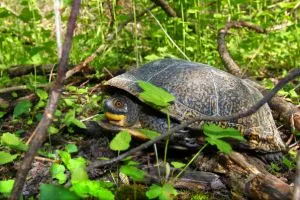
- Experience Level: Intermediate
- Family: Emydidae
- Scientific Name: Emydoidea Blandingii
- Other Names: N/A
- Adult Size: Between 5 and 8 inches
- Lifespan: Up to 80 years
- Average Price Range: Between $300 and $450
Blanding’s turtles are known as “the turtle that smiles”, and are named after naturalist William Blanding. These turtles have dark oval shells covered in yellow speckles. Their plastrons are yellow with black patches.
Unfortunately, Blanding’s turtles are an endangered species in Missouri, now found only in extreme north eastern and north western counties. They are cautious, often diving to safety at any sign of trouble.
Blanding’s turtles are omnivorous, mainly eating crayfish, earthworms, and water-borne invertebrates. They also occasionally eat plants, and do not rely on water to help them swallow unlike many other species of turtle.
2. Eastern River Cooter
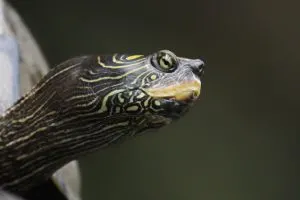
- Experience Level: Beginner to Intermediate
- Family: Emydidae
- Scientific Name: Pseudemys Concinna Concinna
- Other Names: N/A
- Adult Size: Between 8 and 12 inches
- Lifespan: Between 20 and 40 years
- Average Price Range: $20 to $50
- Recommended Books: Aquatic Turtles: Sliders, Cooters, Painted, and Map Turtles by R.D. Bartlett
Eastern River Cooters are freshwater semi-aquatic turtles native to southern counties of Missouri. They can sometimes be seen basking on rocks or logs at the edge of the water, but are notoriously difficult to capture.
These turtles have slightly domed shells ranging from brown to olive. Their shells and heads have beautiful yellowish markings, while their plastrons are also yellow. Eastern River Cooters can breath underwater.
Eastern River Cooters are mainly herbivores, preferring to eat vegetation and fruits rather than meat such as fish or insects. They are usually found in rivers and streams.
3. Ornate Box Turtle
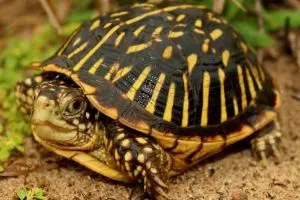
- Experience Level: Intermediate to Expert
- Family: Emydidae
- Scientific Name: Terrapine Ornata
- Other Names: Box Tortoise, Western Box Turtle
- Adult Size: Between 4 and 5 inches
- Lifespan: Up to 28 years in captivity, up to 40 years in the wild
- Average Price Range: Between $130 and $450
- Recommended Books: Box Turtles (Complete Herp Care) by Tess Cook
Ornate Box turtles are a colorful species with distinctive patterning on their shells, sporting a series of yellow to orange stripes. Their bodies have light colored speckles on their skin. Ornate box turtles are common across much of Missouri.
Ornate Box turtles are found in higher concentrations in Missouri’s northern and western areas, but can be seen almost everywhere. Their preferred habitats are open, grassy areas.
These turtles are active during the day and forage for food. They are mostly carnivorous and eat earthworms, insects, and occasionally carrion. They will also eat plants such as berries or cacti.
4. Three-toed Box Turtle

- Experience Level: Beginner
- Family: Emydidae
- Scientific Name: Terrapene Carolina Triunguis
- Other Names: Box turtle
- Adult Size: Between 5 and 7 inches
- Lifespan: Between 50 and 100 years
- Average Price Range: Between $250 and $450
- Recommended Books: Box Turtles (Complete Herp Care) by Tess Cook
A subspecies of the Eastern Box turtle, Three-toed Box turtles are found across most areas of Missouri. The main habitats for these turtles are woodlands and other grassland areas such as meadows.
Three-toed Box turtles have high domed carapaces which are usually brown or olive in color. They also have three claws on their hind-legs, as their name implies, rather than four. Their plastrons are yellowish in color.
These turtles are mainly terrestrial and roam around on land in search of food. Three-toed Box turtles are omnivores will eat fish and invertebrates as well as plants.
5. Western Chicken Turtle
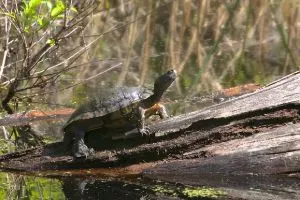
- Experience Level: Intermediate
- Family: Emydidae
- Scientific Name: Deirochelys Reticularia Miaria
- Other Names: N/A
- Adult Size: Between 4 and 10 inches
- Lifespan: Between 15 and 30 years
- Average Price Range: Between $130 and $200
- Where To Buy: theturtlesource.com
Western Chicken turtles are on of the three subspecies of the chicken turtle and are a semi-aquatic species that have very long, striped necks and oval shaped shells. Coloring ranges from brown to olive ringed with yellow, with patterns that resemble a net.
Sadly the Western Chicken turtle is an endangered species in Missouri thanks to the loss of its preferred habitats, and is now found in only a few places in the south eastern swamps.
Western Chicken turtles are omnivores who mainly feed on crustaceans, fish and invertebrates as well as plants. They prefer slow-moving waters.
6. Common Map Turtle
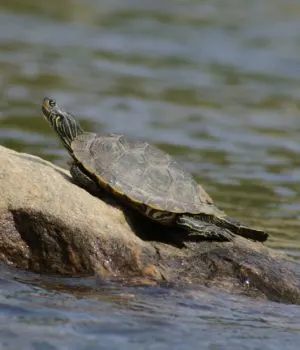
- Experience Level: Beginner
- Family: Emydidae
- Scientific Name: Graptemys Geographica
- Other Names: Northern Map turtle
- Adult Size: Between 4 and 10 ½ inches
- Lifespan: 15 to 20 years
- Average Price Range: Between $20 and $60
- Where To Buy: turtlestore.com
- Recommended Books: The Map Turtle and Sawback Atlas: Ecology, Evolution, Distribution, and Conservation by Peter V. Lindeman
These beautiful turtles are named for their markings, which resemble the contours of a map and are often yellow in color. Common Map turtles have dark brown or olive green shells. Small yellow spots behind the eyes separate the Common Map turtle from its subspecies.
Common Map turtles are mainly found in the central regions of Missouri. They are a mainly aquatic species and rarely venture far from the water. They are brilliant swimmers and like to bask.
Common Map turtles are mainly carnivorous, feeding on fish and aquatic invertebrates like crayfish, but will occasionally eat vegetation.
7. False Map Turtle

- Experience Level: Beginner
- Family: Emydidae
- Scientific Name: Graptemys pseudogeographica
- Other Names: N/A
- Adult Size: Between 3 ½ and 10 ½ inches
- Lifespan: Between 30 and 50 years
- Average Price Range: Between $6 and $40
- Where To Buy: turtlesource.com
- Recommended Books: The Map Turtle and Sawback Atlas: Ecology, Evolution, Distribution, and Conservation by Peter V. Lindeman
False Map turtles usually dwell near larger rivers like the Mississippi that run through Missouri’s central areas. They rarely travel far from the water, and like to bask on outcrops over the water surface.
False Map turtles have dark shells, often brown or black and have contour-like yellow markings. As the turtle ages, this pattern gets fainter. Most adults have a pronounced keel on their backs.
To distinguish themselves from other Map turtles, False turtles lack colored patches and markings on their heads. This species is omnivorous and eats aquatic invertebrates, crayfish, and aquatic plants.
8. Ouachita Map Turtle
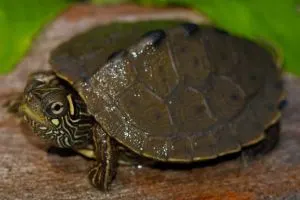
- Experience Level: Beginner
- Family: Emydidae
- Scientific Name: Graptemys Ouachitensis
- Other Names: N/A
- Adult Size: 3 ½ to 5 inches for males, 5 to 10 inches for females
- Lifespan: Between 15 and 20 years
- Average Price Range: Between $40 and $100
- Where To Buy: theturtlesource.com
- Recommended Books: The Map Turtle and Sawback Atlas: Ecology, Evolution, Distribution, and Conservation by Peter V. Lindeman
Ouachita Map turtles can be distinguished from other Map turtles by the large yellow spots on the sides of their heads. Males have a prominent keel protruding from their dark green shells.
Ouachita Map turtles are found in the central counties of Missouri, mainly in the Ozark region’s rivers. They are active during the day and like to bask. They are easily startled and will jump into the water.
As with many other turtles, Ouachita Map turtles are omnivores. They mainly eat mollusks, aquatic larvae, and plants.
9. Mississippi Mud Turtle
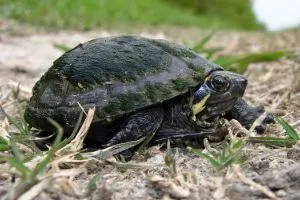
- Experience Level: Beginner
- Family: Kinosternidae
- Scientific Name: Kinosternon Subrubrum Hippocrepis
- Other Names: N/A
- Adult Size: Between 3 and 5 inches
- Lifespan: Up to 50 years
- Average Price Range: $40 to $100
Mississippi Mud turtles are a rare species in Missouri, found mainly in the swamps in south eastern counties. They like shallow, slow-moving waters, especially swamps, tidal marshes, or bogs. They are semi-aquatic and often move around on land.
These turtles have smooth, oval shaped carapaces that range between brown and yellowish in color. Their shells drop quite sharply at the sides and back, whilst their plastrons are yellowish with brown patches.
Mississippi Mud turtles are omnivorous and mainly eat worms, snails and other mollusks and sometimes fish. They will also eat plants.
10. Yellow Mud Turtle
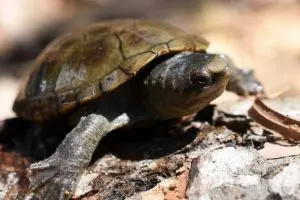
- Experience Level: Intermediate
- Family: Kinosternidae
- Scientific Name: Kinosternon Flavescens Flavescens
- Other Names: Yellow-necked Mud turtle
- Adult Size: Between 3 and 5 inches
- Lifespan: Between 10 and 40 years
- Average Price Range: Between $150 and $295
- Where To Buy: theturtlesource.com
Yellow Mud Turtles are one of the smallest species in Missouri and are very rare, only appearing in a handful of south western counties. They mainly inhabit marshes and ponds and like to burrow and dig, often in sandy areas.
These small turtles have unmarked, dark shells. Their plastrons are yellow, and they may also have some yellow coloring around their face.
Yellow Mud turtles mainly eat crustaceans, aquatic invertebrates, and mollusks. They mainly catch their prey in the water, and can consume food either in the water or on land.
11. Common Musk Turtle
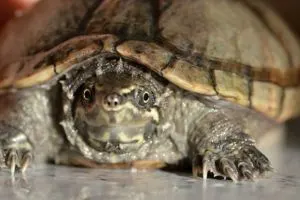
- Experience Level: Intermediate
- Family: Kinosternidae
- Scientific Name: Sternotherus Odoratus
- Other Names: Stinkpot, Eastern Musk turtle
- Adult Size: Between 4 and 5 inches
- Lifespan: 50 years and over
- Average Price Range: Between $20 and $90
- Where To Buy: theturtlesource.com, undergroundreptiles.com
Common Musk turtles are also known as “Stinkpots” due to the strong smell they can release from their musk glands, which they use to protect themselves from predators. They are Missouri’s smallest native species and mainly inhabit southern and south western areas.
Common Musk turtles have dark, unmarked shells. Their heads are also dark, with yellow lines along their faces. They prefer marshy and boggy habitats.
An omnivorous species, Common Musk turtles hunt for prey by scent. They mainly eat mollusks, crayfish, small fish, and tadpoles. They aren’t strong swimmers, so do not really chase prey.
12. Painted Turtle
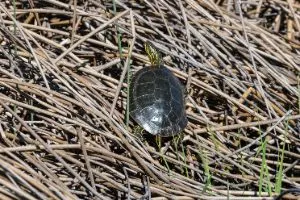
- Experience Level: Beginner
- Family: Emydidae
- Scientific Name: Chrysemys Picta
- Other Names: N/A
- Adult Size: Between 4 and 10 inches
- Lifespan: Between 30 and 50 years
- Average Price Range: Between $20 and $50
- Recommended Books: Painted Turtle Pet Owners Guide by Ben Team
Two Painted turtle subspecies are native to Missouri; the Southern Painted and the Western Painted. Painted turtles often have dark shells with faint yellow stripe markings.
Southern Painted turtles can be distinguished by their yellow plastrons and are found in a select few south eastern counties. Western Painted turtles have darker plastrons, with olive green shells and inhabit much of the remaining areas of Missouri.
Mainly an aquatic species, Painted turtles stay near the water and like to bask. Painted turtles are omnivorous and mainly eat small amphibians, mollusks, and invertebrates. They must swallow their food in the water.
13. Red-eared Slider
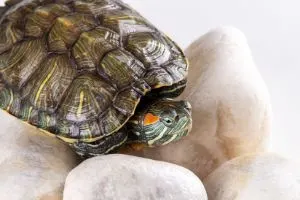
- Experience Level: Beginner
- Family: Emydidae
- Scientific Name: Trachemys Scripta Elegans
- Other Names: Water Slider turtle, Red-eared Terrapin
- Adult Size: Between 6 and 8 inches
- Lifespan: Between 20 and 40 years
- Average Price Range: Between $15 and $50
The Red-eared Slider is one of the most popular species of pet turtle on the market. This semi-aquatic species is found all across Missouri.
These turtles like to bask at the water’s edge, and often stack themselves upon each other. Red-eared Sliders prefer warm, slow-moving waters such as rivers and lakes. Their omnivorous diet consists of small fish, aquatic invertebrates, and underwater vegetation.
Red Eared Sliders commonly have an olive green shell, with yellowish striped markings on their scales. Their heads are usually a darker color, with yellow band markings and red patches just behind their eyes.
14. Alligator Snapping Turtle
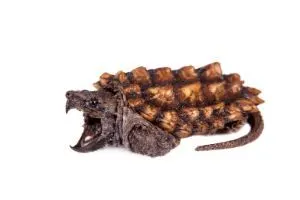
- Experience Level: Intermediate to Expert
- Family: Chelydridae
- Scientific Name: Macroclemys Temmincki
- Other Names: Loggerhead Snapper
- Adult Size: Between 15 and 26 inches
- Lifespan: Between 60 and 70 years
- Average Price Range: Between $25 and $60
Alligator Snapping turtles are the largest freshwater turtle species in the world and are instantly recognizable. They have thick ridged, spiked shells and incredibly strong, beak-like jaws. They are usually dark brown in color.
These mighty turtles are aquatic and live in deep waters like lakes or rivers. They are a rare species in Missouri, mainly confined to the extreme south eastern counties.
Alligator Snapping turtles are carnivores, and will essentially eat anything they can catch. They will even eat other turtle species. Their strong jaws are capable of crushing their prey.
15. Common Snapping Turtle
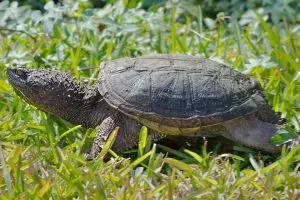
- Experience Level: Intermediate to Expert
- Family: Chelydridae
- Scientific Name: Chelydra Serpentina
- Other Names: Common Snapper, Eastern Snapping turtle, Snapper
- Adult Size: Between 8 and 20 inches
- Lifespan: Between 30 and 50 years
- Average Price Range: Between $20 and $40
- Recommended Books: Snapping Turtle Pet Owners Guide by Ben Team
Common Snappers are large, freshwater turtles that are common across the whole state of Missouri. They can be aggressive and will often hiss and bite. They do not bask often, preferring to remain in larger bodies of water.
Identified by their distinctive hooked “beaks”, Common Snappers usually have dark brown or green shells. They also have strong claws and long tails that sport saw-toothed ridges.
Common Snappers are nocturnal omnivores, mainly eating fish and other aquatic prey. They also consume underwater vegetation. They can even catch and eat small waterbirds if they get close enough.
16. Midland Smooth Softshell Turtle
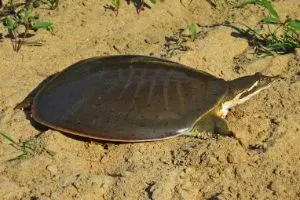
- Experience Level: Intermediate to Expert
- Family: Trionychidae
- Other Names: Spineless Softshell
- Scientific Name: Apalone Mutica Mutica
- Adult Size: 4 ½ to 7 inches for males, 6 ½ to 14 inches for females
- Lifespan: 25 years and over
- Average Price Range: Between $40 and $60
- Where To Buy: theturtlesource.com
- Recommended Books: Softshell Turtle Owners Guide by Ben Team
The Midland Smooth Softshell is a subspecies of the Smooth Softshell, and is common to many areas of Missouri. They mainly inhabit larger rivers, but may be in decline due to the losses of their specialized sand habitats.
Midland Smooth Softshells look like leathery pancakes, and do not have hard shells to protects themselves. They are usually brown or gray, with lines running from behind their eyes and snouts.
They are active during the day and bury themselves in sand in the shallows at night to sleep. They mainly eat insects, but also mollusks and crayfish.
17. Eastern Spiny Softshell Turtle
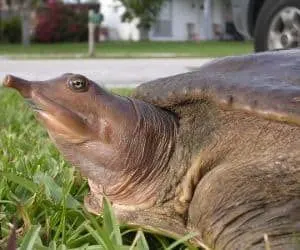
- Experience Level: Intermediate to Expert
- Family: Trionychidae
- Scientific Name: Apalone Spinifera Spinifera
- Other Names: N/A
- Adult Size: 5 to 9 ½ inches for males, 7 to 17 inches for females
- Lifespan: Between 20 and 50 years
- Average Price Range: Between $70 and $280
- Recommended Books: Softshell Turtle Owners Guide by Ben Team
Eastern and Western Spiny Softshells are Missouri’s two native subspecies of Spiny Softshell turtle. They both inhabit the areas of the state that their names dictate. Western Spiny Softshells are also found in central counties of Missouri.
Spiny Softshell turtles have a pancake-like shell with dark circles. Their skin feel like sandpaper, and they have long, tapered beaks. Three subspecies of Spiny Softshell are native to Louisiana.
These turtles are the fast swimmers. They are carnivores and will feed on any crustaceans, invertebrates, and mollusks they can find. They also occasionally eat aquatic plants.
Conclusion
And that wraps up our list of the 17 species of native turtles in Missouri. We’ve covered several different families of turtles on this list, including the Common Map turtle and Ornate Box turtle. We’ve also looked at threatened species such as the Western Chicken turtle.
Did you enjoy this list? If you did, and are thinking about finding one of these turtles as a pet, check out our care guides. Also, don’t forget to comment below and share your thoughts with fellow turtle enthusiasts!
Other nearby states
- Turtles in Arkansas
- Turtles in Illinois
- Turtles in Iowa
- Turtles in Kansas
- Turtles in Kentucky
- Turtles in Nebraska
- Turtles in Oklahoma
- Turtles in Tennessee

Sandy
Saturday 15th of April 2023
Trying to identify a baby turtles found in our backyard today. There are lots of big turtles in a pond behind our house. We thought they were alligator turtles, but now know they are not. Their necks are really long and they like to bask in the sun. They spook easy and go back in the water quickly. Exciting to see.
Mary Mielke
Thursday 7th of October 2021
I enjoyed this and have seen a species that appears to have cross bred. Box turtles and some of them are different. I didn't see an example of them.